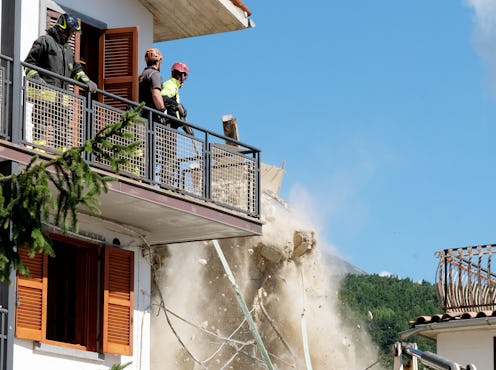News
This Man Saw The Italy Earthquake Coming
The earthquake which struck central Italy in the early hours of Wednesday morning took scores of lives, and it could have potentially been prevented, according to the country's leading geologists. One man, geologist Gian Vito Graziano, predicted the devastating effects of the Italy earthquake two years ago, and he warned that the state of Italy's building codes could lead to more deaths in the future.
2014 was the five-year anniversary of the earthquake in L'Aquila, in which 300 people were killed when the quake struck in the middle of the night, including seven young adults in a student housing facility which collapsed. Graziano, president of Italy’s National Council of Geologists, spoke about the need for enforced anti-earthquake regulations, saying that current building standards could have led to "thousands, not hundreds" of deaths had the students been in school.
The same applies to the earthquake which struck Wednesday. The damage was limited because it hit in the middle of the night, but had people been in the towns' larger buildings when they collapsed, many more deaths could have occurred. The death toll was relatively low, but certainly substantial enough to make one retroactively wish that more had been done when the opportunity was still available.
The death toll in the three destroyed towns — Amatrice, Accumoli, and Arquata del Tronto — is nowhere near the high end of Graziano's estimate, but it's still more severe than it might have been if previously proposed reforms had been enacted. In 2002, after a school collapsed in Puglia, the Italian government ordered a study of all the public buildings in areas prone to seismic activity.
According to The Guardian, some of that proposed reform was never enacted, including reinforcements to the student housing in L'Aquila which collapsed just six years later. It's unknown if any reinforcements were proposed or completed in Amatrice, Accumoli, and Arquata del Tronto, but the three towns sit right in the center of the earthquake-prone region, so it's likely that some reforms were at least put forth.
Another issue that may have contributed to the severity of the earthquake damage is illegal construction of buildings. According to the Italian government statistics office, about 18 percent of buildings are constructed illegally — a proportion far exceeding that of most other developed nations. According to Reuters, school buildings are particularly susceptible — just 9 percent are built to withstand earthquakes. Without the proper regulation and oversight, buildings won't be able to survive natural disasters, and could prove even more dangerous in the future.
Granziano tried to warn his country that the risk of people dying from earthquakes was rising due to substandard building codes and enforcement. The three devastated towns now have a long road to recovery before them — one that could take many years to see through to the end. Hopefully, reinforced building standards will be part of the reconstruction, so as to safeguard against further tragedies.
